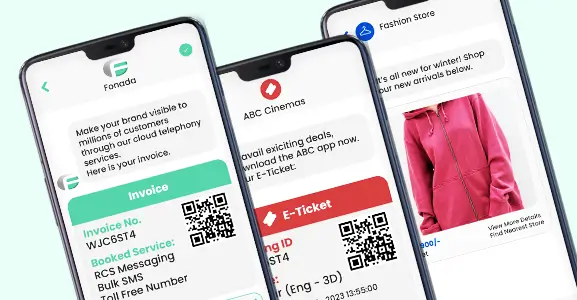Are you still using traditional contact center technology? Is your call center facing losses?
If yes, then you are in the right place. There could be several potential reasons, such as poor call connectivity, a low call connect ratio, or using outdated technology behind your call center’s low performance.
Only cloud call center managers feel the pain of not achieving the desired ROI (return on investment) even after putting all their efforts and dedication into it.
If you can relate to this, trust me; you need to upgrade to cloud call center technology. This simple yet effective switch will help you achieve maximum outcomes with your current resources.
Cloud call center solutions offer highly advanced customer engagement and collaborative tools for businesses, aiming to streamline business communication.
In this blog post, we will discuss cloud contact center technologies in detail and how it helps enterprises achieve desired operational efficiency.
What Is Contact Center Technology?
Contact center technology refers to the combination of advanced business communication tools and software that empower businesses to run their call centers efficiently while creating a positive CX. This technology enables enterprises to smoothly facilitate inbound and outbound customer communications and optimize the entire customer experience.
Collaborative tools and services, such as auto dialer, IVR, OBD, click-to-call solutions, etc., help businesses efficiently handle a high volume of customer calls and maximize the outcome by empowering agents. IVR enables enterprises to streamline the call flow by offering efficient call-routing solutions for instant query resolution and excellent service delivery.
Omni-channel capabilities of cloud-based call center solutions help businesses drive highly effective and meaningful customer conversations. Capabilities like AI-powered chatbots empower businesses to answer customer queries 24/7 without assigning human resources during post office hours. These bots are also trained to engage customers in real-time.
Businesses that want to strengthen their customer relationships and compete with competitors in the highly clustered business environment must invest in the right call center technology for survival. This technological adaptation requires upfront investment in cloud software and complete agent training.
Benefits Of Using Cloud-Based Contact Center Technology?
Cloud based Call center technologies assist businesses by streamlining their communications with customers and optimizing operations for maximum results. Below is a full explanation of how contact center technologies benefit your business, customers and agents.
Improved Operational Efficiency And Agent Productivity
Contact Central technologies are the combination of various collaborative tools and services that help businesses effectively manage the high volume of customer queries efficiently. IVR is one of the most valuable services that help businesses automate the call routing process. With this, agents can efficiently focus on critical tasks.
IVR Technology helps businesses connect customers with the appropriate agent for their queries and issues without being on a waiting list for a more extended period. Process automation tools help customers reach the right resource efficiently, which contributes to higher customer experience and increased agents’ productivity.
Personalized Customer Experience
Offering a personalized CX is the need of the hour. It has been proven by several research studies that most customers stop doing business with a brand that fails to offer personalized experiences and interactions. With advanced contact center technology, businesses can manage a proper database for each customer with their queries and requirements. Accessibility to complete customer details empowers agents to create personalized interactions and gain customer loyalty, strengthening customer relationship bonds.
Streamlined Omnichannel Support
The contact center’s cross-channel integration capabilities enable agents to assist customers on their preferred communication channels while retaining the context of previous interactions. Leveraging omnichannel contact center supports not only helps call centers gain customers’ loyalty but also helps them provide a seamless customer experience.
Improved Performance
Cloud contact center solutions come with advanced analytical tools that enable supervisors to fetch the complete track record of processes. Having detailed performance analytics empowers businesses to evaluate valuable insights for improving overall performance and agent productivity.
Top 11 Contact Center Technologies In 2024
Contact center technology enables businesses offer seamless and high-quality customer support across channels.
The list of the top 11 technologies for call center operations are given below:
Voice Over Internet Protocol (VoIP)
VoIP empowers businesses to make and receive phone calls over the web. This eliminates the dependency on wired landline setup for making business calls. VoIP-enabled devices offer users flexibility, enabling them to work remotely. With the help of VoIP devices, businesses don’t have to invest enormous amounts of money to set up a dedicated call center for customer queries. Businesses can run remote call centers with basic equipment and arrangements.
Predictive Dialer
Outbound call center empower businesses to connect with potential prospect for better sales, market reach and lead generation. Manually dialing is tedious and prone to higher human error. With Predictive dialing businesses can efficiently eliminates overhead and achieve higher engagement rates by automating call queueing and call placement with leads.
Computer Telephone Integration (CTI)
Computer telephone integration acts as a bridge between phone and computer system for sharing information. This technology empowers call center agents to connect with customer databases with contextual information efficiently through customer engagement platform.
Call Queuing
Call queuing helps call center agents to place inbound calls on hold and then route them to the most appropriate agents. This technology lets customers connect with agents or departments for instant query resolution.
Automatic Call Distribution (ACD)
Automatic call distribution (ACD) as technology enables call centers to route inbound calls to available agents. The ACD system utilizes a predefined set of criteria and different types of attribute-based routing to connect the customers with the right department or agents.
Skill-Based Routing
Skills-based routing directs callers to agents with specific skills and problem-solving abilities. It connects the caller to someone with the expertise to solve everyday challenges customers face on a specific issue.
Priority-Based Routing
It is a type of routing that helps call centers to prioritize urgent issues to the top of the queue. This ensures that agents promptly address all important customer queries, fostering a better customer experience.
Interactive Voice Response (IVR)
Interactive voice response (IVR) comes with automated menus that help callers reach the appropriate agents for their queries and issues. It also offers customers self-service options that empower them to resolve basic queries through menu options. It works in parallel with ACD to route customers accurately based on their input. IVR gets input via spoken responses or touch-tone. (If you want to know your current balance account, PRESS 1, or to continue with this conversation, say Yes). Thus, IVR eliminates human dependency on answering basic customer queries if you follow the best practices.
Call Recording
Call recording tools enable call centers to record customer interaction with agents for quality assurance. In this way, they can track the quality of the service offered by their agents. This is quite an effective way of gaining customer insights and valuable information. However, call centers are instructed to comply with privacy guidelines when recording customer interactions with their agents.
Data Analytics
Evaluating agents’ performance and identifying areas for improvement is necessary for businesses to achieve desired growth. Data analytics empowers businesses to measure key performance indicators for evaluating agent performance and scope of improvement. By accessing detailed insights on performance, call centers can efficiently work on the areas in which they are lagging. Also, with this information call centers can take the necessary steps to improve call centers’ performance.
CRM Integration
Contact center CRM integration with the existing system improves operational efficiency by allowing you to access advanced collaborative tools in your tech stack. This integration enables call centers to leverage customer relationship management (CRM) software which allows them to facilitate smooth data flow. With the help of this CRM, agents can have completed information of the previous purchase history of customers, which empower them to resolve customer queries in a real-time.
AI Chatbots
Chatbots, also known as virtual agents, are programmed software designed to answer customers’ basic queries about a product or service. These bots independently solve common customer issues, reducing agent workload.
For example, with the help of chatbots, a call center can answer basic FAQs, schedule appointments, and navigate users to track order details. In short, chatbots help businesses function even after regular office hours and improve customer experience.
Omnichannel Integration
Omnichannel contact center integration streamlines data flow, enabling agents to seamlessly engage customers across channels, ensuring a consistent experience. Without integrated contact center channels, agents waste time toggling between platforms, resulting in repetitive questions that frustrates customers. Investing in digital channels is crucial for meeting customer needs, necessitating contact centers to provide integrated support across SMS, live chat, video, and voice for optimal customer experience.
Latest Customer Support Trends In Contact Center Technologies
Keeping customers happy means staying ahead of the game. Advancement in call center technologies empowers businesses predict customers needs and offer instant resolution to their queries.
Let’s break down the hottest trends in contact centers today
AI Assistants
Imagine having super-smart helpers who know what your customers want before they ask. That’s AI in action! It helps by:
- Chatbots that give personalized help, not just canned responses.
- Smart tools that handle tasks and suggest answers, so agents can focus on what matters.
- Understanding how customers feel, so agents can respond with care.
Cloud Power
Say goodbye to bulky hardware and hello to the cloud! It’s all about:
- Being flexible, so you can grow and change with ease.
- Letting agents work from anywhere if they have internet and a headset.
- Adding innovative ways for customers to reach you, without a big overhaul.
Ready to give your customer service a boost? Dive into these trends and watch your support soar!
Choosing The Right AI For Your Contact Center
Choosing the right AI for your contact center requires in-depth research. Today’s call center technologies helps businesses leverage innovative customer engagement tools for higher productivity and operational efficiency. Start by identifying the specific challenges and goals you want AI to address in your call center. This could include reducing call waiting times, improving first-call resolution rates, or automating routine tasks.
Understand AI Capabilities
Explore the different types of AI technologies available for call centers, such as natural language processing (NLP), speech recognition, sentiment analysis, and machine learning. Understand how each of these can enhance customer interactions and agent efficiency.
Assess Integration
Consider how the AI solution will integrate with your existing call center infrastructure, including your CRM system, telephony platform, and any other relevant software. Seamless integration is crucial for a smooth implementation process and ongoing operation.
Evaluate Scalability
Ensure that the AI solution can scale with your call center as it grows. This includes both handling increasing call volumes and adapting to new requirements or functionalities over time.
Budget Considerations
Determine your budget for implementing AI in your call center. Compare the costs of different AI solutions, considering upfront expenses, ongoing maintenance, support, and potential savings or ROI.
Vendor Reputation And Support
Research the reputation and track record of AI vendors you’re considering. Look for customer reviews, case studies, and testimonials to gauge the quality of their products and support services.
Pilot Testing
Consider conducting pilot tests or proof-of-concept trials with select AI solutions to evaluate their performance in real-world call center environments. This can help you make more informed decisions and identify any potential issues or limitations before full deployment.
Compliance And Security
Ensure that the AI solution complies with relevant regulations and industry standards, especially regarding data privacy and security. Verify that the vendor has robust measures in place to protect sensitive customer information.
By carefully considering these factors and conducting thorough research, you can integrate Artificial Intelligence (AI) in a contact center that aligns with your business objectives and delivers tangible benefits to your customers and agents.
Best Practices For Contact Center Automation Using Call Center Technologies
Best practices for contact center automation involves identifying repetitive tasks, self-service options, AI tools, integrated system etc. using current contact center technology.
Here’s How?
Identify Repetitive Tasks
Start by identifying repetitive and rule-based tasks in your call center, such as call routing, data entry, or simple inquiries. These tasks are prime candidates for automation.
Implement Self-Service Options
Offer self-service options for routine customer inquiries through IVR systems, chatbots, or online portals. This allows customers to find answers to common questions without the need for agent intervention, reducing call volume and wait times.
Use AI-Powered Tools
Utilize AI-powered tools like natural language processing (NLP) and sentiment analysis to improve the efficiency and effectiveness of customer interactions. These tools can help route calls more accurately, provide personalized responses, and identify customer sentiment to guide agent interactions.
Integrate Systems
Integrate your call center automation solutions with other systems and databases, such as CRM platforms and knowledge bases. This ensures that agents have access to up-to-date information and can provide better assistance to customers.
Provide Agent Assistance
Implement automation tools that provide real-time assistance to agents during calls, such as suggested responses, knowledge base access, and next-best-action recommendations. This helps agents handle inquiries more efficiently and improves the overall customer experience.
Monitor And Optimize
Continuously monitor the performance of your call center automation tools and identify areas for optimization. Analyze key metrics such as call resolution times, customer satisfaction scores, and agent productivity to fine-tune your automation strategies.
Offer Omnichannel Support
Extend automation capabilities across multiple channels, including phone, email, chat, and social media. This ensures a seamless experience for customers regardless of how they choose to contact your call center.
Train And Empower Agents
Invest in training programs to help agents adapt to automation tools and focus on higher-value tasks such as complex problem-solving and relationship-building. Empower agents to use automation as a tool to enhance their productivity and effectiveness.
By following these best practices, you can leverage call center automation to streamline operations, improve customer service, and drive overall business efficiency.
FAQs
AI add self-service capabilities along with process automation in content centers which enable them to streamline business communication and achieve higher operational efficiency. This results in instant query resolution, which contributes to a better customer experience.
There are six types of call centers available for optimizing customer experience, which includes
- Inbound call center
- Outbound call center
- Combined call center
- Automated call center
- Omnichannel call center
- Multichannel call center
The cost of contact center technology can vary depending on several factors, such as the number of features available, AI capabilities, number of seats, size of the contact center, deployment model etc.

Dec 11, 2024
Top Contact Center Optimization Tools For 2024
“A thriving business knows how to fetch maximum output from limited resources by optimizing ca... Read More
Nov 13, 2024
What Is Brand Communication? CPaaS Role Explained
Did you ever wonder why some advertisements grab your attention instantly, while others do not? The... Read More
Nov 01, 2024
What Is Automated Messaging And How Does It Work?
Automated messaging or text automation empowers businesses and marketing professionals to connect wi... Read MoreLatest Updates
From Fonada
Industry Insights, Trends, Innovations, Updates, and Case Studies from Industry Experts
View
Customer
Reviews
Discover why our customers love us - read their authentic and heartfelt reviews!
View
Case
Studies
Explore real-life scenarios, offering analysis, and solutions to practical challenges
View
Convert Leads Into Sales With Fonada
Trusted CPaaS Solution Provider







